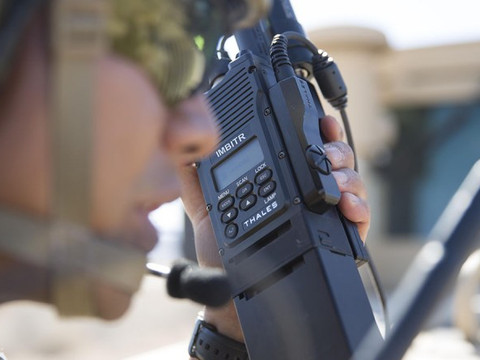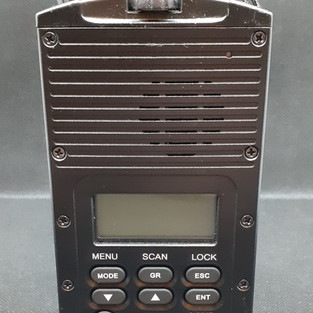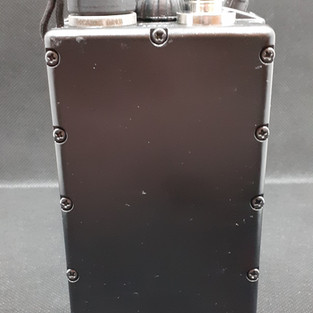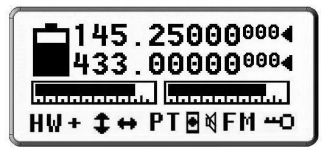Review - TRI AN/PRC-148 (UV) MBITR
- HAHO
- Feb 14, 2021
- 12 min read
Updated: Jun 20, 2021


History of TRI (Triumph Instrument)

TRI (Triumph Instrument) is a Chinese company manufacturing replica PRC variants, ancillaries (PTTs and cabling) and supplying the global market. TRI is enabling those who don't have access to the real steel PRCs and equipment to something that is aesthetically near identical. TRI is one of the respected manufacturers in the radio replica market.
For more info - visit the 'Triumph Instrument - TRI' Facebook page.
Why TRI?
SEAL Teams Bravo utilise radio equipment throughout the seasons, but their typical loadout will include the AN/PRC-148. In other roles such as their low profile or covert roles, they use Motorola handhelds and Sat phones amongst a raft of other comms equipment to suit their operations. Notably though, Bravo favour the AN/PRC-148.
MBITRs are manufactured by Thales Communications (also known as Thales Defense & Security, a subsidiary of the French company Thales Group). The radios are specifically manufactured for US Government contracts, NATO contracts and other specific entities. For that reason, the 148s are kept purely kept within the military / security sector. Their availability outside of these circles is as expected, non-existent. These items are to the US DoD counted as critical operational equipment and therefore sourcing one of these will be near impossible with restrictions on the use, sale or handling of them. You're highly unlikely to find a genuine one on the market for less than a few thousand $ or £. The advice on forums and groups is to steer well clear, unless you'd like law enforcement blowing a hole through your door, roof, garage and cat flap simultaneously...
The other radio seen used by Bravo is the AN/PRC-152 which is manufactured by Thales' competitor Harris. This blog though remains focussed on the AN/PRC-148.
TRI is one of the main manufacturers of replica PRC 148s and 152s currently on the market. Their replicas over time have improved and adapted based on feedback from customers and reflecting the real world radio technology improvements that they've incorporated into their radios.
Communications between personnel when deployed and operating across environments is at the bottom line, essential. Without comms between the team, there could be serious consequences. In pursuit of wanting to continue to build a true SEAL Team inspired loadout I chose their favoured AN/PRC-148 (MBITR).
History of AN/PRC-148 (MBITR)
The AN/PRC-148 (AN - Army / Navy, PRC - Personal Radio Communications) MBITR (Multiband Inter/Intra Team Radio) was developed by the combined efforts of the United States Special Operations Command (USSOCOM) and Thales Communications in the 1990s to provide encrypted, secure and modern battlefield communications that was interoperable between US units and forces deployed. This equipment was later adopted by NATO forces.
Whilst the MBITR has been around for 30 years it's security based rating, relatively low cost and wide range of uses has seen it deployed globally in use by a multitude of forces. Throughout the years Thales Group has not been idle and new technology has been added to the MBITR increasing it's capabilities. An example of this is the JEM-JTRS (JEM - JTRS Enhanced MBITR, JTRS - Joint Tactical Radio System). This upgraded radio provides an additional layer of NSA (National Security Agency) approved encryption and a host of other capabilities to enable secure voice comms and data transmission from the field back to HQ.
Product details
Herein lies the product description from the site purchased from;
The package includes;
Radio
Battery 12V (4800mAH)
Antenna
Charger
Operators manual
Frequencies:
VHF frequency range: 136 - 174.000MHz
UHF frequency range: 400 - 470.000MHz
FM (received): 87 - 108 Mhz
AM (received): 109 - 136 Mhz
Three grades of power:
Low 1W Power saving mode
Medium 5W Personnel radio (flat, open, sparse, light woodland environments)
High 10W Team radio (dense woodland, obstacles, urban environments)
The below image is a copy of the radio specifications provided in the rear of the operators manual.

IP67 ingress protection standard.
Compatible with real military PTT and headset, including; MSA Sordin, Peltor Comtac.
Aluminium Alloy radio body.
Voice encryption & Voice compounding.
Full-font LCD display board.
Double DTMF encoding and decode.
Supports CTCSS/DCS built-in.
Dual mode volume adjustment (rotary knob and button).
Supports 12V general vehicle voltage.
High effect VHF/UHF gain antenna.
Original Thales battery and automatic protection charger is standard.
Compatible with dynamic & flexible mics.
What does it actually mean?
IP67 - this is the International Protection regarding protection of equipment from water, dust, electromagnetic interference etc. Further details for IP can be found on Wikipedia. For the MBITR, the code stands for;
IP - International Protection.
6 - no ingress of dust. Test duration of up to 8 hours based on airflow.
7 - immersion proof up to 1m (3'3") or more. Test duration 30 minutes.
DTMF - dual tone multi frequency. Sound generated when keys pressed & radio generates unique code from sender to receiver.
CTCSS - Continuous Tone-Coded Squelch System. Allows two groups of users to use the same radio frequency.
DCS - Digital-Coded Squelch. Adds a bitstream to the transmitted radio.
Packaging exterior
The MBITR comes in a 38.3 x 15.3 x 8 (L x W x H) simplistic card box weighing 1216 grams in total. The exterior of the box has no markings save for the lid of the box that bears the company and product sticker.
I would highly recommend purchasing a hard case for the MBITR for storage to ensure it's safely stowed during transport or when stored for periods of time.
Packaging interior
The interior as with the exterior is simplistic and is split into 4 sections housing the various parts of the radio; Radio, Battery, Antenna, Charger and Charging platform. The sections are cut from the standard grey packaging foam and provides rigidity to the box and allows compression if dropped preventing any damage or knocks to the equipment inside.
MBITR exterior in detail
The MBITR with battery and antenna attached weighs 873 grams, and 517 grams with antenna but without a battery attached. The exterior is manufactured from aluminium alloy that has been coated black as per the real issued MBITR. The MBITR can be broken down into five parts; Radio, Battery, Antenna, Charger and Charging platform. The MBITR is not a compact system and the comparison with the real steel version is as follows;
TRI Main body & battery = 20.7 cm
THALES Main body & battery = 21.4 cm
TRI Main body & battery + antenna = 54.3 cm
THALES Main body & battery + antenna = 55 cm
TRI Full weight (exc antenna) = 873 grams
THALES Full weight (exc antenna) = 867.5 grams
Comparatively and aesthetically these are near identical with only a few centimetres / grams difference. The main difference as expected comes with the quality of the product and therefore the TRI is unlikely to survive the following conditions that the THALES version can such as;
Operating Temperature - -31° to +60° C
Storage Temperature - -33° to +71° C
Humidity - 95 (non-condensing)
Shock & Vibration - EIA-603-1992
Altitude - 30,000 Feet
Immersion - 2m / 20m versions

Putting the radio together was a quick and simple process and the initial impression of; the weight, exterior finish and 'plug and play / ready to go' feel gave me confidence that the TRI MBITR wasn't going to be fragile and that it was going to be a great item to review.
Having assembled the MBITR, it was time to break it down into its' constituent parts and review each part, delving into the details.
Radio
The main radio component houses all of the electronics parts. Measuring 12.5 x 6.6 x 3.8 cm (L x W x H) it weighs 461 grams. The measurement taken is from the top of the radio (excluding knobs / connectors) to the bottom of the battery connector. If measuring included the knobs and connectors, it would be 13.7 x 6.6 x 3.8 cm (L x W x H).
There are a number of parts on the exterior worth noting. The operators manual does identify these parts, but details are scattered across the many pages. Collating the information I've created the pictures below for ease of reference.


TRI MBITR vs THALES MBITR aesthetics

The TRI MBITR shown on the far left of this image is nearly 1:1 scale with the genuine MBITR. There are obviously a few subtle aesthetic differences which have been highlighted.
1) Screws used on front (and rear) panels are small + variants, small rivet types are used on the MBITR. 2) The speaker / mic is bottom right and not top right of top panel. 3) Manufacturers model / variant info on side is using an incorrect format. 4) TRI markings used under keypad, not THALES marking.
Battery
The battery included is a genuine Thales rechargeable 12.6v Lithium-Ion battery, measuring 8.2 x 6.6 x 3.7 cm (L x W x H) and weighing 356 grams. The battery has the correct NSN markings - NSN: 6140-01-487-1153. Of note is that as marked in the description, these batteries are genuine / used and therefore they do have marks / scratches on them.
There are a number of parts worth noting, however these are not named / identified in the operators manual and have been sourced from online reference materials.


The Thales MBITR Lith-Ion Rechargeable Battery, 4800 mAH capacity, provides the MBITR with a minimum of a 10 hour duration broken down into 3 parts; 1) 10% transmit at 5W, 2) 10% receive and 3) 80% radio being on standby. The hours can be increased if the radio is sat in standby. Of interest is that the 4.8 battery is the Thales standard version, with the 5.8 being labelled as high capacity.
Antenna
The package included 2x black rubber antennas instead of one. The antennas provided measure 33.6 x 1.7 x 1.7 cm (L x W x H) and weigh 56 grams each. These antennas are identical and have the TRIUMPH marking on one side and on the other have the markings 'Ant, Broaband BFT' and a CAGE and P/N (Part Number).
The markings whilst obviously not correct are designed to emulate those found on the genuine article, the Thales PRC-148 V5C & V6C MBTR Broadband BFT 30-152Mhz Antenna, images of which are shown below for reference.
Charging platform

The 12V charging platform included simply pushes down onto the battery and twists, with the male wing connectors affixing into the female wing connectors. The 3 pin connections are then made, and the battery lock pin engages ensuring the charging platform cannot twist off. Once connected, the battery is able to charge from a mains socket.
Charger
With the MBITR being manufactured and shipped from China, the charger as expected will likely not meet European or US safety standards. For safety reasons, I highly recommend that you replace this charger and cable as soon as possible to conform to your country safety standards i.e. the plug containing a fuse, ensuring that it's also compatible with the charging platform.
Technical Specifications
The below sections relate to a number of features, parts and settings that are worth noting on the MBITR. Radios can be simple to setup and used with little or no changes required. The TRI MBITR is exactly that. It's ready to use out of the box with no setting up required. They can also become overly complicated very quickly, but can be configured in a multitude of ways. Based on your requirements and whether you want to setup and go, or undertake some configuration, I highly recommend watching a number of Youtube reviews and walkthroughs for the MBITR to get an understanding of the possibilities and limitations. I further advise you to read the manual and get to know the menu choices and their functions as this will help you in the long run.
LCD Screen
The featured LCD screen is a dot-matrix variant with a dim yellow backlight. The screen is used to access the menu and to display the users chosen settings. There are a large number of icons which are seen and the operators manual lists them for your information. It's advised to have a read through and understand what each of the icons represents.
The Big 3
There are in my opinion three key features when setting up the radio to ensure it's done so correctly; frequencies, CTCSS & DCS. Getting these parts right at the start saves issues appearing further down the lines. It's advisable that if operating with others, that the frequencies / channels used and the CTCSS and DCS settings are setup in advance of any operations.
Frequencies
The below are the standard PMR (Private Mobile Radio) channels and associated frequencies which can be initially used. It's advisable that you utilise the CTCSS and DCS if enabled to ensure that your comms are kept separate from others who may also use your channel. Changing frequencies on the MBITR is quick and simple, using only a few button presses.
Channel 1 446.00625
Channel 2 446.01875
Channel 3 446.03125
Channel 4 446.04375
Channel 5 446.05625
Channel 6 446.06875
Channel 7 446.08125
Channel 8 446.09375
Channel 9 446.10625
Channel 10 446.11875
Channel 11 446.13125
Channel 12 446.14375
Channel 13 446.15625
Channel 14 446.16875
Channel 15 446.18125
Channel 16 446.19375
CTCSS (Continuous Tone-Coded Squelch System)
CTCSS simplistically allows two groups of users to use the same radio frequency. If CTCSS is enabled by one group, it adds a low frequency audio tone to the voice. If the other group does not have the identical CTCSS enabled, there will be no crossover of voice. Both groups therefore re still transmitting, there is some interference but generally it is not noticeable. Of note is that the CTCSS doesn't offer security as others can change their CTCSS settings to match yours.

For more information and detailed explanation, visit the Wikipedia page here or visit the RadioReference Wiki here.
DCS (Digital-Coded Squelch)
DCS is also known as CDCSS (Continuous Digital-Coded Squelch System). DCS was designed as a digital replacement for CTCSS and adds a bitstream to the transmitted radio. Like CTCSS, DCS again enables two groups of users to utilise the same radio channel without crossover or interference.

For more information and detailed explanation, visit the RadioReference Wiki here.
Audio / PTT Connector
The A/P Connection on the TRI purchased was the 6 pin standard (a 10 pinvariant was also available for purchase). The 6 pin is generally used by land forces and appears to be more commonly used whilst the 10 pin is generally used by Maritime forces. The 1st two images relate to the wiring of the 6 pin. The third image is that of a 10 > 6 pin adapter which can be purchased and used. Whichever variant you purchase, there are adapters available to allow you to use the TRI MBITR with various other manufacturers equipment. There isn't from research any positives or negatives from using a 6 pin over an 10 pin or vice versa.
Testing
The TRI MBITR is able to operate with nearly every radio on the market from Motorola to Kenwood to Baofeng. For testing purposes I used it in conjunction with a Baofeng UV-5R and ensured that both batteries were fully charged and the MBITR power setting was at 5W.
Both the UV-5R and the MBITR operate in the following ranges;
VHF frequency range: 136 - 174 MHz
UHF frequency range: 400 - 480 MHz
The weather in the test area;
Precipitation: 18%
Humidity: 87%
Wind: 16mph SE
Visibility: Clear
Time: 15:05
Temperature: 2°C

The above chart simplistically shows the results over the various ranges in the various environments the radios were tested in.
Open ground - the MBITR had no problems performing as expected for 5W.
Sparse woodland - apart from 250m when slight interference was experienced it performed well.
Dense woodland - as expected at the furthest range there were audio issues with broken comms.
Urban - again the longer distances and buildings did create severe interference.
Having only tested in these 4 environments locally, I am when able, going to visit different areas to repeat the tests to be able to provide a variety of results for a better conclusion.
Thoughts and opinion
Communications equipment is one of the key components for anyone operating in any environment, whether this be direct comms between team members or from the team back to an HQ element. Keeping abreast of developing situations, having intelligence fed to you regarding the immediate vicinity via ISR and maintaining comms when under contact will increase your survival chances. The huge variety of comms equipment on offer means there are a huge number of available options which you can easily get lost in.
What is the purpose of your comms? Do you just require within team comms, low power and use in an open environment? Do you need comms back to HQ to be fed taskings? Each situation is different and generally each will require a type of comms equipment. Small handheld Motorola radios may be suited to open terrain with line of sight, but more powerful equipment is likely needed to punch through dense jungle foliage or penetrate brick walls in an urban setting.
Think about interoperability with new or existing equipment... Does the radio you want to use require you to purchase a new PTT and headset? Does the benefit outweigh the cost? Again with some comms equipment it only accepts proprietary ancillaries and you may find yourself stuck with or forced into one line of manufacturers if you want all parts to work together. Do you want something small and lightweight to fit into a pocket or something larger for better comms?
If you buy cheap, be prepared to lose comms regularly, get frustrated when your team mates come through broken and the radio in the worst scenario, goes down. Researching through blogs and Youtube reviews will provide some guidance and points of view around certain equipment, however, hands on with what you intend to purchase will be the best option. Availability of parts, cost of parts, technically skilled repairers (based on their location and cost), reliability, total cost etc these are all factors that you need to take into consideration when spending money on comms equipment.
One community I highly recommend joining if you do purchase an MBITR or any radios / equipment purchased by TRI is the 'TRI/TCA Radio MBITR Owners B/S/T' Facebook group. This group has accumulated a huge and vast depth of knowledge and experience around the TRI and TCA equipment.
I'd also recommend purchasing a hard case for it. I purchased separately the Max Case MAX380H115 as I wanted to ensure that the radio was properly protected during transport and from the elements.
Can I recommend the TRI MBITR? Having only tested it locally using the above criteria in the testing section, I've not yet been able to test it properly in a mixture of environments in a mix of scenarios. At this time I hold my judgement, but I am impressed by the quality of the MBITR as it looks and feels 99% genuine and with the amount of resources available, if any issues arise there's a wealth of knowledge and help out there. If you're after something that resembles near exactly the type of comms equipment used in SEAL Team with functionality (rather than just an empty shell) I would say yes, the TRI AN/PRC-148 (UV) MBITR is a worthy investment that will set you apart from others.
Don't forget to check out the HAHO social media platforms below for content, updates and linked articles. Like, Follow, Subscribe and Share!
Final Note
I am not paid for my blogs by the manufacturers or companies that I purchase my items from. I am not offered freebies to promote a product. These blogs are purely written from my own experience in truth to help advise and inform others who may wish to purchase the items or understand more about them. If I am sent a freebie to review this will be stated at the beginning to make you aware.

































































































